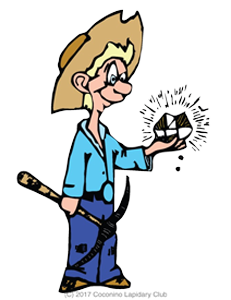I’ve been an avid collector of mineral specimens from around the world since my experience, at the age of 13, of finding a beautiful black tourmaline crystal while on a Boy Scout hiking adventure. We were in the upper limits of the gem mining Pala District in San Diego County, California. I’m now 84 and still. . . Read More
Mineral Man
Who Is That Masked Mineral Man?
USE OF COLOR IN MINERAL IDENTIFICATION
In some minerals color is directly related to a metallic element, is characteristic, and can be useful in identification. As examples, azurite as shown in Figure 1A, is always blue due to the presence of copper, and rhodochrosite, shown in Figure 1B, is always pink to red due to the presence of manganese,. However minerals such as fluorite, colorless in it self, can be yellow, blue, purple, or green due to low concentrations of metal impurities.
FRACTURE IN MINERAL IDENTIFICATION
Fracture in mineralogy is the texture and shape of the surface formed when the mineral is fractured. Fracture differs from cleavage and parting, which involve clean splitting along a plane surface, as it produces rough irregular surfaces [Ref1]. The appearance of fracture surfaces among minerals is highly varied and is a useful tool in identification. In this part of my Blog I’ll describe the fracture surfaces broadly seen in minerals.
GALLERY OF CHINESE CARVED JADE ART
o the great advantage of the beauty of their art, Chinese carvers of jade were guided by themes and decorative motifs in the shaping of their carvings and the choices of decorative motifs adorning them[Ref1-7].
HISTORY OF JADE CARVING IN CHINA
From the late Neolithic Age (circa 3500 BC-2070 BC) into today the crafting of jade art objects in China has produced beautiful and magnificent art objects which exhibit remarkable diversity of both color and form as shown by the carved nephrite jade pendant with phoenix pattern and the funerary Bi Disc with rain pattern in Figure 1[Ref1]. In this blog I’ll describe the tools and techniques with their technological advances and show corresponding art objects of increasing complexities of design and execution.
MINERAL STUFF: THE GEMSTONE JADE
Since ancient times jade[Ref1] has been used by artisans to create beautiful jewelry and works of art. Art objects of jade have been carved in China for more than 6000 years[Ref2] as exemplified by the jade dragon carved during the Zhou Dynasty (5th – 4th century BC) as shown in Figure 1. In Central America,. . . Read More
PALEONTOLOGY OF AMBER
In this Blog I’ll describe how biomaterials including animal and plant fossils are included and preserved in amber formed from tree resin, which by its stickiness can entrap objects which contact its surface as shown in Figure . With further addition of the resin the object is sealed within the resin and out of the. . . Read More
MINERAL STUFF: AMBER, THE GEM
Amber is a hard resin formed from tree sap by fossilization and is many millions of years old[Ref1]. Since Neolithic times (about 9000-3000 BC) and before the Copper Age[Ref]2) amber has been highly valued as a gemstone and used to create beautiful jewelry and artworks. Wide use of amber in Early Europe and in the. . . Read More
Meteorites
Meteorites are stuff from outer space; each is a solid piece of debris which formed from dust within the protoplanetary disc or from object such as an asteroid, planetesimal, or planet, and which travels through space and falls through the atmosphere to the surface of earth. As alien objects which fall dramatically they have evoked. . . Read More
Precious Coral
Both precious red and black corals are bottom-dwelling sessile marine branched animals that have been harvested at depths between 60 and 20,000 feet [Ref 1, Ref 2]. They have provided lapidarists and other artisans with materials they use to create extraordinarily beautiful jewelry and objects of art, as witnessed by Figures 1 and 2. In. . . Read More
